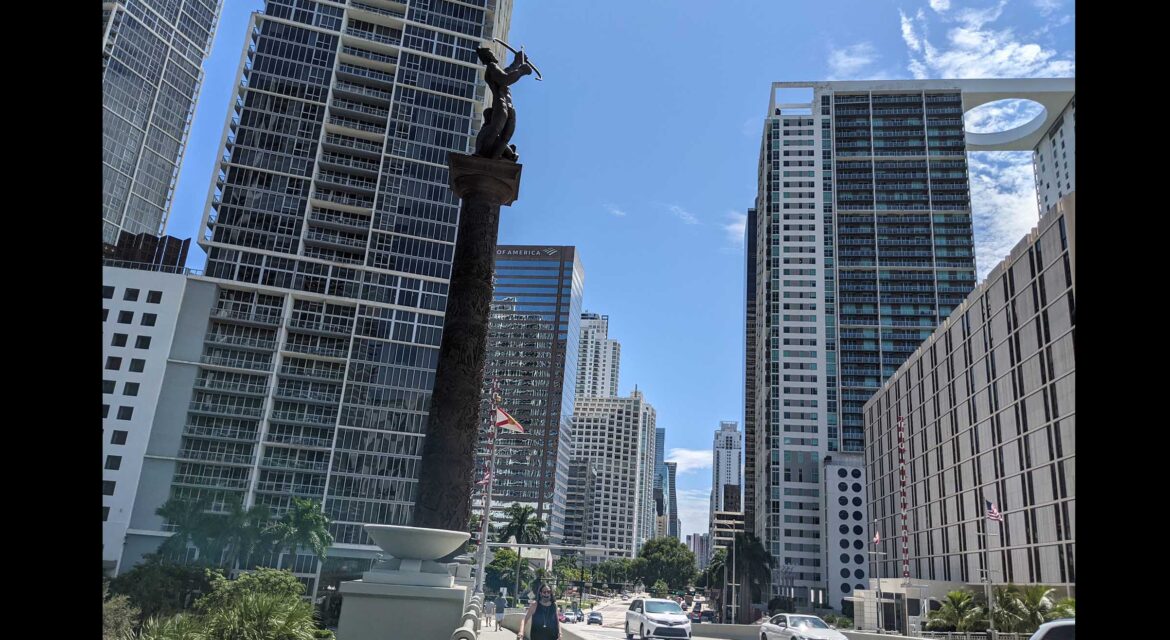 Commissioned by the Florida Department of Transportation in 1995, the “Pillar of History” is a 36-foot high carved column that graphically narrates the lives of the Tequesta Indians, in Miami, Florida. Created by Cuban Master Sculptor Manuel Carbonell, the piece as well as various markers that are thematically connected to multiple eras and aspects of Miami to give it a sensation of eternity.
Commissioned by the Florida Department of Transportation in 1995, the “Pillar of History” is a 36-foot high carved column that graphically narrates the lives of the Tequesta Indians, in Miami, Florida. Created by Cuban Master Sculptor Manuel Carbonell, the piece as well as various markers that are thematically connected to multiple eras and aspects of Miami to give it a sensation of eternity.
Honoring the Tequesta Indians
 Providing adornment to the otherwise plain Brickell Avenue Bridge, “The Pillar of History” has been decorated with 158 figures that depict the natural and cultural settings of the Tequesta Indians, who were the first residents of the area. The top features a 17-foot “Tequesta Family” bronze sculpture that portrays a Tequesta Indian warrior aiming an arrow to the sky, with his wife and child by his side.
Providing adornment to the otherwise plain Brickell Avenue Bridge, “The Pillar of History” has been decorated with 158 figures that depict the natural and cultural settings of the Tequesta Indians, who were the first residents of the area. The top features a 17-foot “Tequesta Family” bronze sculpture that portrays a Tequesta Indian warrior aiming an arrow to the sky, with his wife and child by his side.
In the niches of the bridge piers are bronze bas reliefs honoring important Miami pioneers Henry Flagler, Dana A. Dorsey, William and Mary Brickell, Marjory Stoneman Douglas and Julia Tuttle. All four reliefs depict them in their historical perpetual settings. Twelve bronze bas-reliefs of Florida fauna are also located at the base of the flagpoles on the walkways of both sides of the bridge.
In all of his work, Carbonell searched for the essence of the form and the absence of detail while empowering a feeling of monumentality to his sculptures, all of which can be seen across “The Pillar of History” and the various markers that further shape the landmark. He wanted to empower a feeling of monumentality to his sculptures, which the column itself does on multiple levels. The various reliefs provide a further connection to the history and legacy of the region, allowing residents and visitors to experience the history of the area in ways that are extraordinary.

A Legacy of Multiple Pieces of History
 Multiple pieces of regional history and culture define the forms and figures that make up the “Pillar of History” while very different elements of Miami history and culture are reflected in the reliefs that are located across the Brickell Avenue Bridge. This connection to multiple elements of the history and culture of the entire region illustrates what a feeling of monumentality can look like in a physical and spiritual sense, highlighting how an effort to imaginatively celebrate such things can transform spaces in ways that are as profound as they are eternal.
Multiple pieces of regional history and culture define the forms and figures that make up the “Pillar of History” while very different elements of Miami history and culture are reflected in the reliefs that are located across the Brickell Avenue Bridge. This connection to multiple elements of the history and culture of the entire region illustrates what a feeling of monumentality can look like in a physical and spiritual sense, highlighting how an effort to imaginatively celebrate such things can transform spaces in ways that are as profound as they are eternal.


